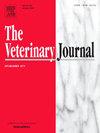猪流行性腹泻病毒灭活疫苗中鞭毛蛋白保守结构域的佐剂作用。
IF 3.1
2区 农林科学
Q1 VETERINARY SCIENCES
引用次数: 0
摘要
鞭毛蛋白通过toll样受体5 (TLR5)激活免疫应答,可作为疫苗佐剂。在这项研究中,我们评估了三种不同细菌鞭毛蛋白保守结构域的佐剂作用:鼠伤寒沙门菌、枯草芽孢杆菌和蜡样芽孢杆菌。保守结构域被重组表达,这三种重组蛋白在体外表现出强大的TLR5激活。以猪流行性腹泻病毒(PEDV)灭活疫苗配制重组蛋白,接种小鼠进行免疫评价。结果显示,与单独使用pedv组相比,这三种重组蛋白均增强了促炎反应(IL-6和TNF-α)、细胞免疫和pedv特异性抗体反应。在病毒中和试验中,所有三种重组蛋白都显著提高了PEDV疫苗引起的中和效价。我们得出结论,尽管它们的序列不同,但来自三种细菌的鞭毛蛋白的保守结构域可以激活TLR5,并可能作为疫苗佐剂。本文章由计算机程序翻译,如有差异,请以英文原文为准。
Conserved domains of flagellin as adjuvants for an inactivated vaccine against porcine epidemic diarrhea virus
Flagellin activates immune response through Toll-like Receptor 5 (TLR5) and can serve as a vaccine adjuvant. In this study, we evaluated the adjuvancy of the conserved domains of flagellins from three different bacteria: Salmonella typhimurium, Bacillus subtilis, and Bacillus cereus. The conserved domains were recombinantly expressed, and all three recombinant proteins demonstrated robust TLR5 activation in vitro. The recombinant proteins were formulated with inactivated porcine epidemic diarrhea virus (PEDV) as vaccines and mice were vaccinated for immune evaluation. Results showed that all three recombinant proteins enhanced proinflammatory response (IL-6 and TNF-α), cellular immunity, and PEDV-specific antibody response, when compared to the PEDV-alone group. In a virus neutralization test, all three recombinant proteins significantly enhanced the neutralization titer elicited by the PEDV vaccine. We conclude that despite differences in their sequences, conserved domains of flagellins from the three bacteria can activate TLR5 and may serve as vaccine adjuvants.
求助全文
通过发布文献求助,成功后即可免费获取论文全文。
去求助
来源期刊

Veterinary journal
农林科学-兽医学
CiteScore
4.10
自引率
4.50%
发文量
79
审稿时长
40 days
期刊介绍:
The Veterinary Journal (established 1875) publishes worldwide contributions on all aspects of veterinary science and its related subjects. It provides regular book reviews and a short communications section. The journal regularly commissions topical reviews and commentaries on features of major importance. Research areas include infectious diseases, applied biochemistry, parasitology, endocrinology, microbiology, immunology, pathology, pharmacology, physiology, molecular biology, immunogenetics, surgery, ophthalmology, dermatology and oncology.
 求助内容:
求助内容: 应助结果提醒方式:
应助结果提醒方式:


